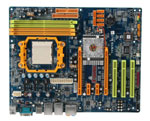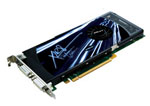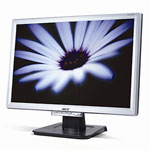November 2007 Budget Buyers' Guide
by Jonathan Maloney and Jarred Walton on November 8, 2007 4:00 AM EST- Posted in
- Guides
AMD Budget Gaming
Leaving the entry-level sector behind, and with a budget of roughly $1000, our options increase significantly. Our aim here is to provide a configuration that allows for a nice balance of performance at stock speeds, while also giving capability and headroom for overclocking. This doesn't mean you have to spend over $1000 though, as we can trim some of our more extravagant options to keep the price to around $950 - a slightly slower CPU, a smaller hard drive, or even a smaller LCD will all help keep our budget to under $1000. For now however, this remains our pick for a budget gaming system that will carry you through the next round of DX10 titles coming our way - and all with nary a red face in sight.
Although current wisdom tells us GPU performance is more of a factor than CPU numbers, at resolutions of 1280x1024 and below - or with RTS and simulation games - the CPU can still play a role in framerates. Frequently it can be the line between a game being playable and a desire for a bigger and better video card. At resolutions of 1680x1050 and higher, games generally become less CPU-bound than before, and the focus is definitely on the GPU. For our budget gaming system, we've picked the Athlon X2 5000+. Running at 2.6GHz, this offers more than enough performance for current games and at an excellent price.
For overclockers, the Black Edition with its unlocked multiplier is certainly an interesting alternative. At $20 more than the standard X2 5000+ Windsor core, the addition of an unlocked multiplier and a 65W Brisbane core is very attractive - at least from an enthusiast perspective. Users across our forums are hitting speeds in excess of 3.3GHz (we hit 3.6GHz with water cooling), and at speeds above AMD's highest X2 offering - the X2 6400+ - this is a budget overclocker's dream. However, you need some sort of cooling for the CPU, as the Black Edition doesn't include a heatsink. You might have a spare, but if you don't and you prefer not to break the bank, we'd recommend the Scythe Ninja Plus Rev. B. That's a pretty hefty price increase purely for overclocking, so we're listing that as an alternative that would add a total of $55 to the system price.
We've paired the X2 5000+ Black Edition with the Biostar TForce TF570SLI, a perfect match for those looking to squeeze as much performance out of their money as possible. The inclusion of dual PCI Express x16 allows users to add a second video card later, budget permitting. The NF570 SLI chipset may have been on the market for some time now, but it's certainly not in the same category as the budget IGPs from AMD, Intel, and NVIDIA. Aside from name changes and added feature sets, the performance of the NF570SLI is still top-notch. Given that NVIDIA skipped the NF6 chipset for AMD systems, and that the AMD 690G and GeForce 7000 series is IGP (and therefore less overclocking-friendly to some degree), we feel this is the best low-budget option for performance and build quality. The SLI support really isn't necessary, although the 8800GT is warming us to SLI quickly in part to Cyris. It's still difficult to find any reasonable alternatives that would save money and still be worth considering so this board is a logical choice.
We're sticking with the Ballistix sticks for now (at the time of writing the $40 rebate offer was still valid for another ten days); however, options are plentiful for a budget of $50 should Crucial decide against renewing their rebate deal. Quality DDR2-800 RAM from Corsair, OCZ, G.Skill, Mushkin, and GeIL are available on any of the major online retailers. Just be sure to look for RAM with timings of 4-4-4-12 - or luck permitting, with Micron D9GMH ICs.
As the heart of any gaming system, what can we choose for the video card? Just two weeks ago, the 8600 GTS would have been a likely candidate - or perhaps the 8800 GTS 320MB for those willing to spend more money - and performance would have varied from being mildly underwhelming to being pretty good. Right now, however, and at a delightful $250 price point, NVIDIA has the brand new 8800 GT 512MB based around the G92 core - essentially a die shrink from 90nm to 65nm, with some other tweaking involved. Performance is phenomenal for this price; benchmarks show results that nip at the coat tails of the 8800 GT's bigger brothers - the $500 8800 GTX, and at resolutions lower than 1920x1200, even the $700 8800 Ultra.
The remaining components have received slight upgrades over our entry-level configuration. We bumped up to a 320GB hard drive, still from Samsung. If you'd prefer a longer warranty, look at Western Digital or Seagate (but be prepared to spend a few dollars more). We selected a Raidmax Apex case with a 400W PSU, and we managed to include a laser keyboard and mouse set and 5.1 speakers both from Logitech. Again, on the overclocking side of things, seriously consider a better PSU if you can manage it.
We faced the same issue that often appears in our Budget/Midrange Guides when it came to the display selection. We could have selected a cheap 22" from Hanns-G - the HG-216DPO that retails at just $214.99 - but instead we went with a higher quality 20" Acer AL2016W, saving us $35 in the process.
We get all this in a system that retails for a little over $1,000? What more could you want? If you want to upgrade or downgrade any of the areas, there are plenty of options. The 4000+ CPU from the base system would still be sufficient for most gaming, a smaller hard drive only impacts storage capacity, and the slightly larger display isn't strictly necessary either. In terms of upgrades, you can look at our last Midrange Guide for some alternatives.
Leaving the entry-level sector behind, and with a budget of roughly $1000, our options increase significantly. Our aim here is to provide a configuration that allows for a nice balance of performance at stock speeds, while also giving capability and headroom for overclocking. This doesn't mean you have to spend over $1000 though, as we can trim some of our more extravagant options to keep the price to around $950 - a slightly slower CPU, a smaller hard drive, or even a smaller LCD will all help keep our budget to under $1000. For now however, this remains our pick for a budget gaming system that will carry you through the next round of DX10 titles coming our way - and all with nary a red face in sight.
| AMD Budget Gaming PC | |||
| Hardware | Component | Price | Rebates |
| Processor | AMD Athlon X2 5000+ (2.6GHz 89W Windsor 2 x 512KB L2) |
$110 | - |
| Motherboard | Biostar TForce TF570SLI AM2 nForce 570SLI ATX |
$88 | - |
| Memory | Crucial Ballistix 2GB (2x1GB) DDR2-800 PC2-6400 | $90 | $40 |
| Video Card | PNY GeForce 8800GT 512MB PCI-e 2.0 HDCP | $260 | - |
| Hard Drive | Samsung SpinPoint T Series HD321KJ 320GB 16MB 7200RPM SATA 3.0GB/s |
$75 | - |
| Optical Drive | Samsung 20X DVDRW/DL SH-S202G | $28 | - |
| Case | APEX TU150 Black Steel ATX with 400W | $59 | - |
| Display | Acer 20" AL2016WBbd 5ms Widescreen DVI (1680 x 1050) |
$200 | - |
| Speakers | Logitech X-530 70W RMS 5.1 | $55 | - |
| Input | Logitech LX-710 Laser Black USB | $55 | - |
| Operating System | Microsoft Vista Home Premium OEM | $112 | - |
| Bottom Line | $1132 | $1092 | |
 |
For overclockers, the Black Edition with its unlocked multiplier is certainly an interesting alternative. At $20 more than the standard X2 5000+ Windsor core, the addition of an unlocked multiplier and a 65W Brisbane core is very attractive - at least from an enthusiast perspective. Users across our forums are hitting speeds in excess of 3.3GHz (we hit 3.6GHz with water cooling), and at speeds above AMD's highest X2 offering - the X2 6400+ - this is a budget overclocker's dream. However, you need some sort of cooling for the CPU, as the Black Edition doesn't include a heatsink. You might have a spare, but if you don't and you prefer not to break the bank, we'd recommend the Scythe Ninja Plus Rev. B. That's a pretty hefty price increase purely for overclocking, so we're listing that as an alternative that would add a total of $55 to the system price.
 |
We're sticking with the Ballistix sticks for now (at the time of writing the $40 rebate offer was still valid for another ten days); however, options are plentiful for a budget of $50 should Crucial decide against renewing their rebate deal. Quality DDR2-800 RAM from Corsair, OCZ, G.Skill, Mushkin, and GeIL are available on any of the major online retailers. Just be sure to look for RAM with timings of 4-4-4-12 - or luck permitting, with Micron D9GMH ICs.
 |
The remaining components have received slight upgrades over our entry-level configuration. We bumped up to a 320GB hard drive, still from Samsung. If you'd prefer a longer warranty, look at Western Digital or Seagate (but be prepared to spend a few dollars more). We selected a Raidmax Apex case with a 400W PSU, and we managed to include a laser keyboard and mouse set and 5.1 speakers both from Logitech. Again, on the overclocking side of things, seriously consider a better PSU if you can manage it.
 |
We get all this in a system that retails for a little over $1,000? What more could you want? If you want to upgrade or downgrade any of the areas, there are plenty of options. The 4000+ CPU from the base system would still be sufficient for most gaming, a smaller hard drive only impacts storage capacity, and the slightly larger display isn't strictly necessary either. In terms of upgrades, you can look at our last Midrange Guide for some alternatives.










63 Comments
View All Comments
JarredWalton - Thursday, November 8, 2007 - link
I don't know if the performance is as good in every area, but they are very quiet, cool running, and I have several that have not caused me any trouble. I have plenty of Seagate and WD drives as well. Outside of the Raptor drives (which are LOUD!) I couldn't tell which drive is which without looking at the case or running some sort of utility to look.Martimus - Thursday, November 8, 2007 - link
Why was the display price $10 cheaper on the Intel build than the AMD build?JarredWalton - Thursday, November 8, 2007 - link
Jonathan originally selected a D-Sub only LCD, and we switched to a DVI model. Missed the price updates, though. It ends up being $20 more for DVI, but it's definitely worth the money in my book. Prices should all be correct now (I hope).Martimus - Friday, November 9, 2007 - link
The display is still $10 cheaper on the Intel non-gamer build.JarredWalton - Friday, November 9, 2007 - link
Ah... I updated the gamer builds and missed the base builds. Fixed.Martimus - Friday, November 9, 2007 - link
Thanks. I was originally confused as to whether there was a rebate on the monitor if you bought an Intel chip with it or something. Maybe I should do something like this to update my old computer, because it doesn't really need to be top of the line or anything.crimson117 - Thursday, November 8, 2007 - link
Windows Vista Home Premium OEM costs $112 - that's over 18% of the computer's cost!You could cut the price of the computer down to $486 if you used Ubuntu instead of Windows Vista. If you were really cutting costs, you could also get away with 1GB of ram with Ubuntu, although ram is very cheap these days so it wouldn't save that much.
stmok - Saturday, November 10, 2007 - link
Yeah, agreed. Its crazy that if you drop Windows in the "Entry-Level PC" category, you can get a more powerful CPU or even a video card instead of an IGP.Zan Lynx - Thursday, November 8, 2007 - link
I used to use Linux for gaming, until I decided to use Windows again on my newest system. So I can say that while id games are good, and Transgaming Cedega does OK, it is a whole lot easier to use Windows. $112 is 3 or 4 games worth of money. Well worth it to avoid the hassles, in my opinion.I also have an opinion on 1 GB RAM. The Linux laptop I am writing this on only has 1 GB and I often curse it for the slowpoke it is. Combined with a laptop hard drive, 1 GB RAM is not enough. Serious multitasking with many web browser windows, an email client, a RSS client, a NNTP client, 10 or 20 terminal windows, BitTorrent, etc, etc, and before you know it, that 1 GB is almost gone and it certainly reduces your file cache, forcing programs to read disk all the time.
Get as much RAM as you can afford and will fit, I say.
BladeVenom - Thursday, November 8, 2007 - link
You can find the Vista Home Premium Upgrade edition cheaper than the OEM version. And it's better for anyone who builds, and upgrades their PC.